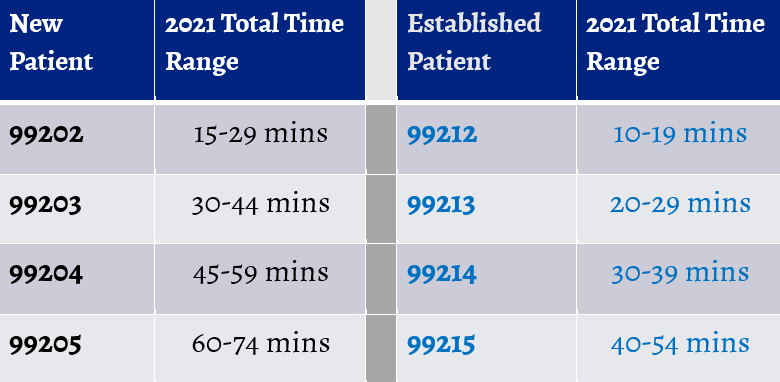Reminder: Guidance only applies to CPT® codes 99202-99215
Summary of Time Changes
- Now based on Total time including face-to-face and non-face-to-face time on date of encounter
- Does not have to be continuous on that day
- No longer “typical times” but defined ranges
- No longer limited to time spent in counseling or care coordination
- New Time Chart
- Time may not include:
- Clinical staff time
- Time spent the day previous or next day, only on date of face-to-face encounter (including telehealth service)
- May only add Prolonged Services (New code +99417) when choosing your code based on time and only when 99205 and 99215 have been exceeded
- A shared or split visit is defined as a visit in which a physician and other qualified healthcare professional(s) jointly provide the face-to-face and non-face-to-face work related to the visit. When time is being used to select the appropriate level of a service for which time-based reporting of shared or split visits is allowed, the time personally spent by the physician and or other qualified health care professional(s) assessing and managing the patient on the date of the encounter is summed to define total time. Only distinct time should be summed for shared or split visits (ie, when two or more individuals jointly meet with or discuss the patient, only the time of one individual should be counted).
2021 Time Ranges for Office-Based E/M Services

Note: 99201 was deleted and 99211 does not have typical time as it will be reported for nurse-only visits or very brief physician visits not meeting the level 2 criteria.
What Services Are Included Under “Time”?
- Preparing to see the patient (eg, review of tests).
- Obtaining and/or reviewing separately obtained history.
- Performing a medically appropriate examination and/or evaluation.
- Counseling and educating the patient/family/caregiver.
- Ordering medications, tests, or procedures.
- Communicating with other health care professionals (not separately reported).
- Documenting clinical information in the electronic or other health record.
- Independently interpreting results (not separately reported) and communicating results to the patient/family/caregiver.
- Care coordination (not separately reported).
Last Updated
08/13/2021
Source
American Academy of Pediatrics